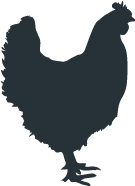Cysts are ballooned, fluid-filled sacs which range in size from the diameter of a pea to the circumference of a baseball. They can develop within, on the surface of, or in the broad ligament close to the ovary and oviduct. Roughly 10-20% of older hens will develop ovarian cysts. Cysts typically don’t cause any problems when they are small, it’s when they grow large that they become problematic. When cysts are large, they are become space-occupying structures within the hen’s body, compressing the surrounding organs and abdominal viscera. This causes the hen’s abdomen to become distended (enlarged). The size of cysts is related to the location they grow from. If they develop within the ovary, they remain small. If cysts develop on the surface of or outside the ovary, there is no restriction in size.
There are several different types of cystic conditions reported in chickens, which include:
- Paraovarian cysts: Cysts do not occur in the ovaries themselves, but arise from the Mullerian or Wolffian ducts, which are part of the broad ligament outside the ovary and oviduct. Occurs in roughly 0.3% of hens with oviduct abnormalities.
- Follicular cysts of the ovary: In some cases, a follicle either does not shed its fluid and shrink after releasing the egg, or it does not release an egg. The follicle swells with fluid, becoming a follicular ovarian cyst.
- Polycystic ovarian condition (POC): Multiple fluid-filled cysts of varying sizes develop on the hen’s ovary. Hens were used as an animal model for the study of POC in humans, since the features are similar to those observed in humans. POC is caused by chronic low-grade inflammation and oxidative stress. Hens will exhibit decreased rate of ovulation (egg laying). POC is often a precursor to the development of ovarian tumors, according to a study which found 6% of hens with ovarian tumors also had POC.
Cyst development may be caused by an endocrine imbalance, chronic inflammation, anatomic abnormalities on the ovary, and pathologic conditions of the ovary. Endocrine imbalance may result from reduction of ovarian function, since the processes (follicular growth, maturation, and ovulation) are regulated by gonadotropins, including FSH (follicle-stimulating hormone), LH (luteinizing hormone), and ovarian steroids. Chronic low-grade inflammation has been associated with the development of polycystic ovarian conditions.
